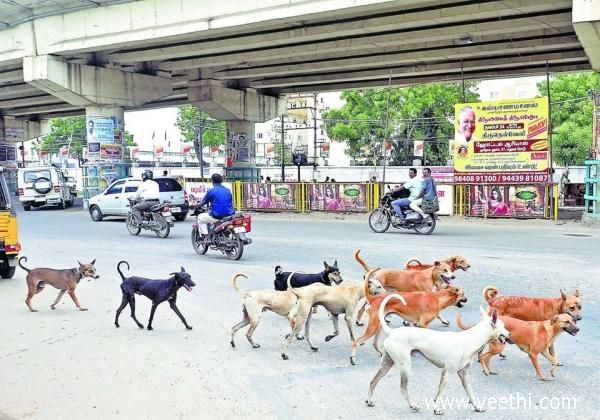After noting a news item on the increasing number of rabies deaths caused by stray dog attacks, the bench of Justices JB Pardiwala and R Mahadevan heard the case.

New Delhi, August 9, 2025 — In a significant ruling that could reshape the way India manages its street dog population, the Supreme Court of India on Friday ordered that all stray dogs in the Delhi-National Capital Region (NCR) be moved to designated animal shelters. The decision, hailed by some as a much-needed step for public safety but criticised by animal rights groups, is expected to affect tens of thousands of stray dogs currently roaming the streets of Delhi and its adjoining cities.
The order came in response to multiple petitions filed over the past few years, citing an alarming rise in stray dog attacks, road accidents caused by canines, and the spread of rabies.
Background of the Case
The issue of stray dog management has been a longstanding public concern in India, particularly in urban centres like Delhi, Noida, Gurugram, Ghaziabad, and Faridabad. Reports of dog bites have increased steadily in recent years. According to municipal health department data, over 55,000 dog bite cases were recorded in Delhi-NCR in 2024, a figure significantly higher than previous years.
Petitioners, including Resident Welfare Associations (RWAs) and parents’ groups, argued that the unchecked growth of the stray population had made certain public spaces unsafe, especially for children and the elderly. They urged the court to take urgent measures, stating that previous municipal sterilisation and vaccination drives had failed to contain the situation.
Details of the Supreme Court Order
A bench headed by Justice Sanjay Kishan Kaul and Justice BV Nagarathna delivered the judgment, directing that:
Immediate Relocation – All stray dogs in Delhi-NCR must be caught and moved to officially designated shelters within the next six months.
Animal Welfare Standards – These shelters must meet minimum standards for animal care, including adequate food, medical facilities, and open space.
Vaccination & Sterilisation – Before relocation, dogs should undergo sterilisation and anti-rabies vaccination to prevent further population growth and reduce health risks.
Monitoring Body – A joint committee, including members from the Animal Welfare Board of India (AWBI), municipal corporations, and NGOs, will oversee the relocation and shelter management process.
Ban on Street Feeding in Certain Areas – The court advised against public feeding of stray dogs in residential areas, suggesting instead that designated feeding zones be created near the shelters.
Justice Kaul, while pronouncing the verdict, said:
“The safety of citizens, especially children, must be paramount. At the same time, the dignity and well-being of animals should not be compromised. Our order seeks to balance both concerns.”
Mixed Public Reaction
The order has sparked intense debate.
Supporters of the Ruling — Many residents in Delhi-NCR welcomed the decision, calling it a relief from daily fear of dog attacks. Social media was flooded with messages from parents sharing incidents of their children being chased or bitten by stray dogs.
Noida Sector 137 inhabitant Rajesh Arora stated:
“We are animal lovers, but the reality is that stray dogs in large packs can be dangerous. My 8-year-old daughter was bitten last year, and it was a nightmare. This decision will make our neighbourhoods safer.”
Critics of the Ruling — Animal rights activists, however, condemned the order, warning that mass relocation could lead to overcrowding in shelters, animal neglect, and even deaths. The People for Animals (PFA) organisation issued a statement saying:
“This order disregards years of scientific evidence that shows sterilisation and street feeding, when done systematically, is the most humane way to control the population. Moving thousands of dogs into confined shelters will only cause suffering.”
Several activists are considering filing a review petition against the ruling.
Challenges Ahead
While the ruling is legally binding, its implementation poses serious logistical and financial challenges:
Population Size: Estimates suggest there are over 2.5 lakh stray dogs in Delhi-NCR.
Shelter Infrastructure: The current number of government-run shelters is insufficient to house even a fraction of this population.
Funding: The cost of building, maintaining, and staffing new shelters is expected to run into hundreds of crores of rupees.
Manpower: Trained personnel will be needed for dog-catching, veterinary care, and shelter maintenance.
Municipal authorities have already begun holding emergency meetings to discuss expansion of facilities and collaboration with NGOs.
Legal and Policy Implications
This ruling could set a precedent for other Indian cities facing similar issues. Bengaluru, Hyderabad, and Lucknow have also been struggling with stray dog-related incidents and may soon see similar petitions in their respective High Courts.
Animal law experts say the Supreme Court’s order effectively redefines the interpretation of Animal Birth Control (ABC) Rules, which previously emphasised sterilisation and release rather than relocation.
Advocate Anjali Sharma, an expert in animal welfare laws, said:
“This verdict marks a shift in the judiciary’s approach — from community-based management to institutional confinement. Whether it will succeed or create new problems remains to be seen.”
Next Steps
The Supreme Court has directed all Delhi-NCR municipal bodies — including NDMC, MCD, Noida Authority, and Gurugram Municipal Corporation — to submit a progress report every two months.
In October 2025, the first relocation phase will start, with an emphasis on school zones and high-density residential regions. The Union Ministry of Fisheries, Animal Husbandry, and Dairy has also been urged by the court to give special funds for the project.
Voices from the Ground
Shelter operators, who may soon see a massive influx of animals, are preparing for an uphill battle.
The owner of a private shelter in Ghaziabad, Sunita Kapoor, stated:
“Even with the best intentions, managing thousands of new dogs will be extremely difficult. Without proper funding and trained staff, we risk turning shelters into overcrowded cages.”
On the other hand, street vendors and delivery drivers, often vulnerable to sudden dog chases, expressed relief. Mohd. Arif, a food delivery rider, said:
“We frequently deal with dogs while working late at night. I’ve fallen off my bike twice. This decision will make our work safer.”
Conclusion
The Supreme Court’s landmark order on relocating stray dogs from Delhi-NCR streets to shelters is a bold attempt to address a long-standing urban challenge. While it promises improved safety for residents, its execution will determine whether it becomes a model for humane urban animal management or a cautionary tale of unintended consequences.
For now, both citizens and activists will be watching closely as the first phase of this massive relocation begins in just a few months.
External Link:All Stray Dogs in Delhi-NCR to Be Moved to Shelters: Supreme Court’s Big Order
for more news click here


